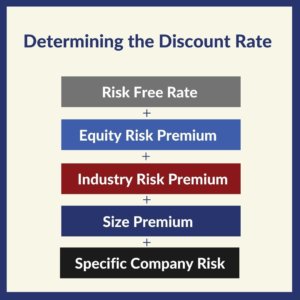Last month we shared that while the value of a business can appear financially complex, at CapVal our goal is to break down complex business valuation topics to help business owners and advisors understand and maximize business value.
At the highest level, the value of a business is based on two key factors: (1) future expected cash flows and (2) a discount rate for calculating those cash flows back to present value (typically the date of valuation). The key to cash flows is that they are future expected cash flows, not relying solely on historical performance. Here we will focus on understanding the components of the discount rate which is also known as rate of return. The discount rate is the rate of return that a buyer would require to invest in that particular business given the risk of those cash flows occurring.
Ultimately the question we are working to answer when developing the discount rate is “what rate of return would a buyer require to invest a dollar in the subject business that compensates for the risk of investing in this particular business as compared to alternative investments?”
Accredited business appraisers use the five factors below to “build up” an applicable discount rate that is specific to the subject business, primarily using public data based on alternative investments. We rely on industry subscription data providers such as Duff & Phelps to provide four of the five factors needed for developing the discount rate. It is the fifth factor, Specific Company Risk, that requires the appraiser’s experienced judgment to analyze the subject company’s qualitative characteristics to determine a reasonable, supportable adjustment. This is an area where our 45+ years of focusing solely on business valuation really helps!

Here’s how we build up the discount rate, adding layers of applicable risk, to ultimately estimate the rate of return a buyer would require to invest a dollar in the subject business:
- 1. Risk Free Rate - A buyer could invest their dollar in the risk free bond market and earn a long-term return of 3% (if the government isn’t manipulating it). This figure is publicly available and is called the ‘risk free rate.’ But the subject business is certainly more risky than the bond market, so we continue to add levels of risk.
- 2. Equity Risk Premium - The investor could also put the dollar in the overall stock market. Data has been tracked since the formal beginning of the stock market (1926) that measures the premium investors require above and beyond the risk free rate to invest in the overall stock market. This is called the ‘equity risk premium.’
If we stop and add these two rates of return together we get the long-term rate of return on the stock market (typically 8-9%). But, the subject business is riskier than the overall stock market, and so we continue.
- 3. Industry Risk Premium - Here we focus on the publicly traded companies that are in the same industry as the subject company. Industry data is collected and risk is measured by price volatility and the risk premium is based on the level of this volatility compared to the overall public market. This risk premium can be a positive or negative number.
If we stop and add these three figures together the answer represents the risk of a long-term investment in publicly traded stocks within the subject company’s industry. But the subject business is still riskier than this and in fact, is missing one of the largest areas of risk--size. And so we continue.
- 4. Size premium - Even the smallest publicly traded companies have a market capitalization, or value, that is much higher than the typical closely held business.
Data collectors take the entire stock market and break it down into 25 different size tranches, or levels, with the additional return required for each tranche. The largest market cap companies are at the top and smallest at the bottom. Because the smallest publicly traded company tranche is still typically significantly larger than the subject privately held business, we start with this smallest tranch data and apply regression analysis to further calculate the additional premium investors would require as a rate of return to invest in a company the size of the subject company.
If you stop here and add the components you’ve now determined the rate of return a buyer would require to invest a dollar in a publicly traded company in the same industry, and further accounting for the size of the subject company. While we have accounted for four of the five risk factors, the last is arguably the most applicable and most dependent on the appraiser’s independence and experience, because we are now accounting for information related directly to the subject company.
- 5. Specific Company Risk - This is where the appraiser’s knowledge of more than just the financial statements is critical. In this prior post we shared details on the qualitative factors that buyers consider--things such as customer concentration, quality of employees and culture, dependence on the owner or key employee(s), and more. It is this factor where the appraiser can increase, or decrease, the discount rate to reflect the specific company’s risks and opportunities that are not previously captured in the projected cash flows. While this is a critically important piece of the discount rate calculation, not all providers of business valuations use the same level of rigor to support this calculation with facts and consistent logic. Our process for every valuation conclusion we develop is to use inputs we would be confident enough to testify in court if ever needed, although the need for that is rare.
These five factors are added together to arrive at the rate of return an informed buyer would require to invest their dollar in the subject business over alternative investments, and therefore impacts the value they would place on the business.
While not every business owner is currently looking to sell his or her business, keeping an eye on how a buyer would look at business value allows the business owner to focus on their business as an investment, which is always a good idea.
If you are interested in understanding more on business valuation topics you can download our ebook An Introduction to Business Valuation, learn more about our free monthly webinar or contact us with your specific business situation. We are here to be a resource for you.

Cathy is the President of Capital Valuation Group, Inc., headquartered in Madison, WI. Capital Valuation Group has been helping business owners across the country understand, increase and unlock the value of their businesses for over 45 years through keynote speaking, valuation analysis, determining damages and providing expert witness testimony. Cathy welcomes conference and event speaking inquiries and can be reached at cdurham@capvalgroup.com.
